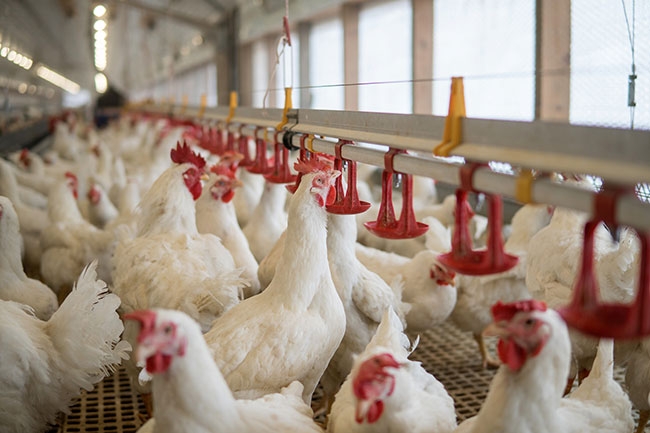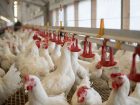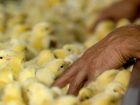
Maximizing broiler performance
By Flavio Henrique Araujo Silva
Features Broilers Production annex Broiler production Canada Lighting Livestock Production Manure Application/Handling Nutrition Poultry litter management Poultry Production ProductionReaching genetic potential through best management practices.
 Flavio Henrique Araujo Silva is associate director technical services with Cobb-Vantress, Inc. Photo: Cobb-Vantress, Inc.
Flavio Henrique Araujo Silva is associate director technical services with Cobb-Vantress, Inc. Photo: Cobb-Vantress, Inc.Raising broilers is much like building a house. A good deal of effort goes into planning and constructing the structure, but one also needs to be a bit of an artist to create the ideal end result. Experienced and knowledgeable growers are similar in that they follow recommended procedures while also being proactive in identifying issues before they can cause a problem.
They are able to read the bird and relate aspects of bird behavior and performance to react quickly and ensure good end results. That’s where the artistry comes in.
To maximize broiler performance, it is important to consider multiple aspects of genetics, chick quality, nutrition, health and environment. Being knowledgeable about the five elements of poultry handling and husbandry – food, water, light, temperature and air quality – is also essential for success.
Litter management
Downtime between flocks is very important if litter is re-used. Some countries use this technique because of high litter material and litter disposal costs while other countries replace litter with every single flock.
The disinfection system used is very important. If litter is replaced with every flock, correct cleaning methods and disinfection are essential to the next flock’s success. If litter is re-used, at least seven days of downtime is necessary between flocks, with the best results varying according to the disease or contamination challenge in the region. Some countries or regions may need 15 to 20 days to get a good disinfection. A recent study by Vaz et al, published in Poultry Science in March 2017 (https://doi.org/10.3382/ps/pex063), showed the differences between the use of quicklime, windrowing and shallow fermentation against the control method of not doing anything.
The results of the study showed the fermentative treatments were superior to the others in terms of reducing the bacterial load, with shallow fermentation standing out with the highest reduction of enterobacteria.
A good or bad flock starts in the hatchery. If you watch chicks after placement, you can easily tell the quality of your chicks and how good the brooding area is. The chicks should be active, looking for water and food, making sounds and be well distributed throughout the brooding house. If we receive excellent quality chicks into a poor brooding area, we lose a fantastic opportunity to do well. The chicks can be ready to go, but without proper house conditions they will not be successful. Additionally, if you receive sleepy, closed eyes, dehydrated, “tired” birds, it’s time to check things at the hatchery because this is not an acceptable condition.
The brooding period is essentiaL
Water needs to be fresh, clean and free of pathogens. Chlorine (three to five ppm) with a good pH (six to seven) will help to achieve the Oxidation-Reduction Potential (ORP) of 550-750, which will kill most of pathogens that could cause a problem for a day-old chick or during the life of the flock.
Feed and nutrition deserve much attention, with establishing feed consistency being a top priority. Birds get used to the quality of the feed, so avoiding a lot of change (from mash, crumble, and pellet) every time a truck arrives to the farm will help the birds to perform their best with the nutrition designed to get the highest results.
Follow the feed schedule designed by nutritionists for your birds. Many times, feeding more or less of a prescribed feed will cause detrimental effects, or in other words, reduce the potential for maximum broiler performance.
Floor and litter temperature is vital in brooding and maximizing performance. Experts are often called to visits where poor initial performance is directly linked to low temperature in the brooding area. The chicks are cold and therefore do not eat or drink. This also causes them to form big chick circles in the warmest areas.
The relation between temperature and air quality is a key environmental factor in performance. Dealing with these two factors properly is key to achieving superb results. Usually the seven-day weights show if this was done correctly from the beginning. Also, when chicks are adults, look to their behaviour inside the house to tell if they are hot. This can be seen in bird activity such as open wings, breathing hard and open beaks. Birds will also display if they are or too cold by all laying down, without going to water or feed lines. The minimum ventilation concept with correct equipment and house control is important to maintaining good condition, saving costs and using the house more effectively.
Worldwide, the season of the year plays an important role in performance, as does the construction of and the environment in the houses. Solid houses have certain requirements, and open houses have their own recommendations. For example, minimum ventilation for a solid wall house with a correct inlet system needs a good control that will work correctly 24-hours a day if maintained properly. In an open house, a successful grower knows the expectation is the same and equipment must be checked daily and work properly in order to be effective.
Examples of tunnel ventilation and correct ambient management are also a good thing to reflect on these days – even with the sweltering summer in the southern hemisphere or the coldest weather in northern hemisphere. The relationship between the building, equipment and the manpower required to manage it are key points to maximizing performance.
Another critical element is proper house maintenance. A new house stops being new when the first flock is placed and later goes to the processing plant. Maximizing results requires an ongoing scheduled house maintenance program.
Don’t forget to check on water consuption and feed consumption – this tells a lot about a flock and can even give clues about diseases, behavior, management and environmental issues.
To optimize broiler performance, we must think about lighting programs, light systems and all the options we have available today in the marketplace. A recent study published by Morrissey et al in July 2017 in the Journal of Applied Poultry Science (https://doi.org/10.3382/japr/pfx029), showed many variances between dimmer styles and types of lamps (LED, incandescent and fluorescent). Be aware of what equipment you’re working with when determining the correct lighting program. Different styles and types of lighting equipment often produce varying results.
In conclusion, to maximize broiler performance we need to give flocks the best conditions we can while utilizing all the theory and understanding available to us. It is an art to apply our knowledge in an effective way to maximize genetic potential.
Print this page

